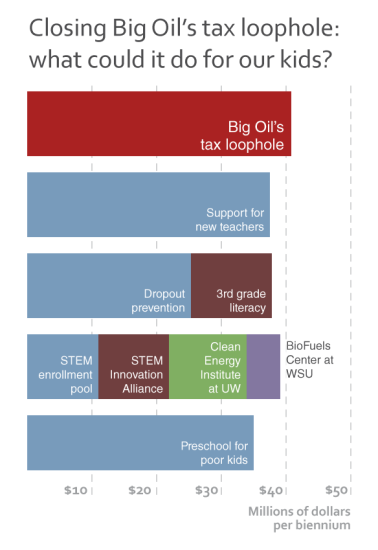Editor’s note: Later posts in this series revise the loophole’s size to $59 million, according to newly available 2014 data from the WA OFM. The $41 million noted below is based on earlier calculations.
In Washington, oil refineries have long benefited from an accidental tax loophole so bizarre that the state’s bi-partisan tax review committee can identify no public policy purpose for it.
With the Supreme Court demanding more money for basic education, both Governor Inslee and the House have moved to close the loophole. Both aim to redirect the $40.8 million from oil companies to classrooms, but some in the Senate are defending the refiners.
So as a way to make clear what closing the loophole would do for public education, here’s a simple graphic explanation:
All figures used in this post come directly from Governor Inslee’s proposed budget, particularly the tax exemption fact sheet and the education funding supplement.
Graphic design by Devin Porter at GoodMeasures.biz.
Notes and sources. By necessity, the labels in the chart are more concise than the language typically used to described these funding categories. The detail-oriented can find fuller explanation below, all of it drawn directly from the governor’s budget:
- Support for new teachers – Fund the Beginning Educator Support Team (BEST) approach for all teachers in their first three years on the job. About 2,000 first-year teachers are hired in Washington each year, and as the state emerges from the recession, our schools will be hiring more. Research shows students of well-supported first-year teachers demonstrate achievement gains equivalent to the students of fourth-year veterans. BEST supports new teachers by including additional paid time for weekly meetings with mentors and more opportunities for peer observation and feedback on teaching. Mentor teachers will receive compensation for taking on this important leadership role. ($37.5 million)
- Dropout prevention – Prevent students in grades six through nine from dropping out. Though districts are able to identify students in these grades who are at risk of dropping out, they need more resources to support them and keep them engaged. School districts will receive additional learning assistance funding based on 15 percent of students in grades six through nine. This money can be used for academic liaisons, tutoring or small-group instruction. Supports will help students who are behind academically to catch up, including those who need additional instructional assistance due to suspensions or expulsions. Again, districts will tailor these research-proven support strategies so they offer the most effective ones to meet their students’ needs. ($25.3 million)
- 3rd grade literacy – Ensure third-grade literacy. Districts will receive a larger allocation for the Learning Assistance Program, which offers extra instructional help to struggling students, based on the prior year’s count of students who did not meet state standard for third grade literacy. Districts will implement literacy activities that work best in their own communities. ($12.5 million)
- STEM enrollment pool – Create a competitive enrollment pool for the public four-year universities. This will help industry fill positions with qualified employees, especially those in STEM fields. Winning proposals must demonstrate innovation and cost efficiency. Such new investment allows us to grow the workforce that our economy needs. ($11.0 million)
- STEM Innovation Alliance – In the past 10 years, science, technology, engineering and math (STEM) jobs have grown three times faster than non-STEM jobs. Skills learned through STEM education are essential in a wide range of employment fields. Governor Inslee’s proposal creates the STEM Education Innovation Alliance to implement a bold, results-driven approach to align the work of state agencies and resources with a comprehensive preschool-through-graduate school strategy to improve the quality of STEM education. The Alliance’s membership of business, labor, nonprofit and education organization partnerships is dedicated to help accomplish the state’s education goals. The proposal also calls for building a talent pipeline from high school to college, and then career, by expanding industry-developed high school skills programs and allowing credits earned in high school to transfer to college. ($10.9 million)
- Clean Energy Institute at UW – Create a Clean Energy Institute at the University of Washington to focus on next-generation energy storage and solar energy. Additional staff, advanced computing support and, most importantly, a clear mission will make the institute a global model in this emerging sector. ($12.0 million)
- Biofuels Center at WSU – Invest in Washington State University’s Center for Bioproducts and Biofuels in the Tri-Cities to leverage new federal and private grants and scale up its promising efforts. Ramping up research funding will help keep the region at the forefront of alternative and biofuels research. ($5.2 million)
- Preschool for poor kids – Expand preschool opportunities. The state’s Early Childhood Education and Assistance Program (ECEAP) supplements the federal Head Start program in providing preschool for low-income 3- and 4-year-old children. Research is clear that for many children, access to high-quality early learning programs improves kindergarten readiness, success in school, graduation rates and outcomes in adult life. Together, however, Head Start and ECEAP serve just two-thirds of the state’s eligible preschool population. The proposal gives access to 3,035 more eligible children and includes quality improvements such as more class time for preschoolers, educator professional development and site visits. ($35.0 million)










Eric Burr
Kids outrank oil companies!